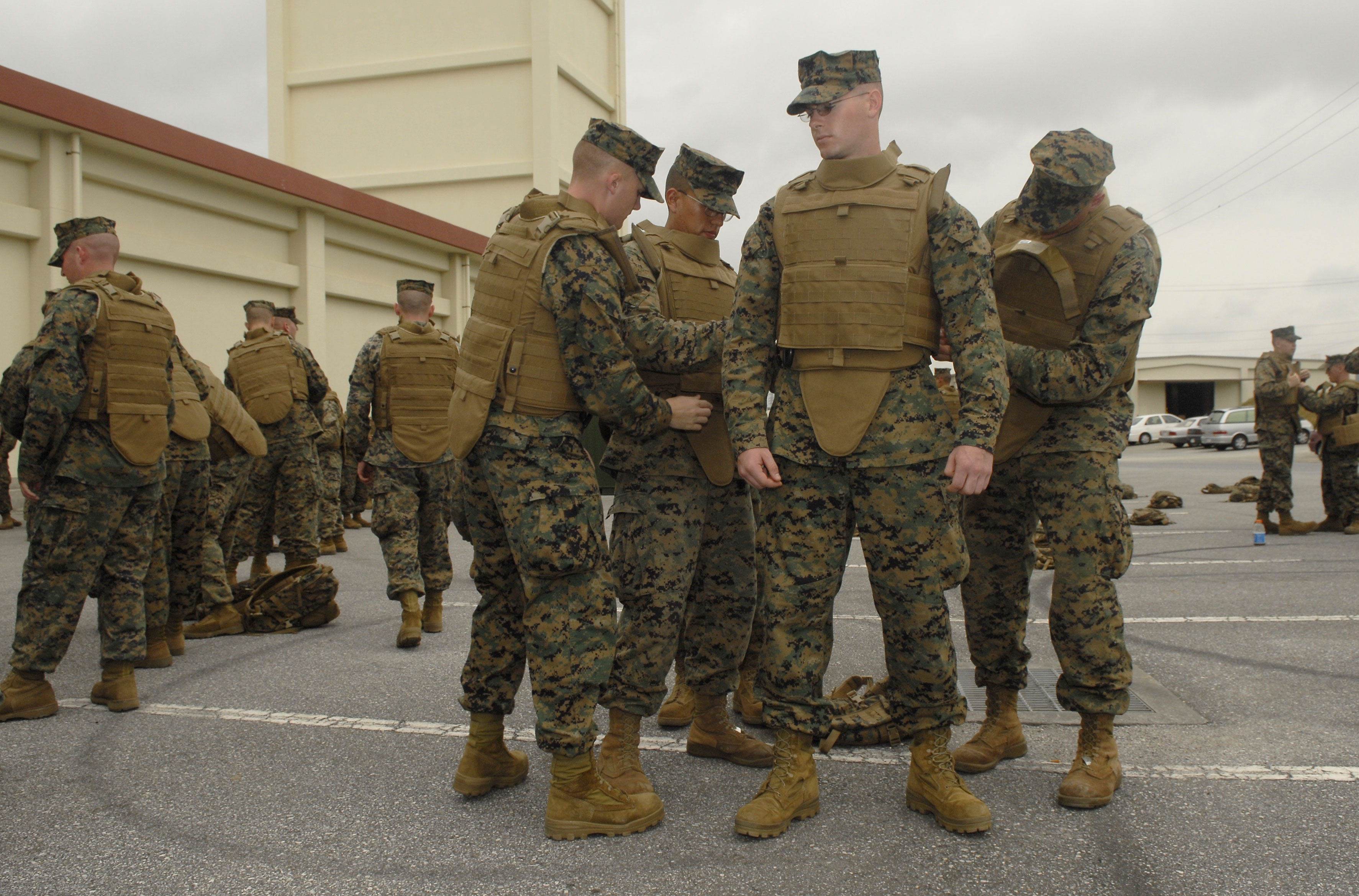Modular Tactical Vest on:
[Wikipedia]
[Google]
[Amazon]

 The Modular Tactical Vest (MTV or MoTaV) is a
The Modular Tactical Vest (MTV or MoTaV) is a
 The MTV includes the following features:
* Quick-release system to remove the vest in emergencies, meant to help corpsmen get to an injured Marine's body. Troops complained that the pull string got caught on equipment and the MTV would accidentally fall off in the middle of battle.
* Greater coverage of the lower back, side torso, and shoulders.
* Integrated side SAPI pouches.
* Integrated channels for communications wiring.
* Rifle bolster to assist in seating the wearer's rifle.
* Same
The MTV includes the following features:
* Quick-release system to remove the vest in emergencies, meant to help corpsmen get to an injured Marine's body. Troops complained that the pull string got caught on equipment and the MTV would accidentally fall off in the middle of battle.
* Greater coverage of the lower back, side torso, and shoulders.
* Integrated side SAPI pouches.
* Integrated channels for communications wiring.
* Rifle bolster to assist in seating the wearer's rifle.
* Same
 In July 2013, the Marine Corps announced its Improved Modular Tactical Vests. The IMTV is made for smaller stature Marines who cannot wear the full-sized MTV comfortably. The vest comes in small-short, medium-short, and large-short sizes. Most Marines use the
In July 2013, the Marine Corps announced its Improved Modular Tactical Vests. The IMTV is made for smaller stature Marines who cannot wear the full-sized MTV comfortably. The vest comes in small-short, medium-short, and large-short sizes. Most Marines use the
dcma.mil
{{Types of armour Ballistic vests United States Marine Corps equipment Military equipment introduced in the 2000s

 The Modular Tactical Vest (MTV or MoTaV) is a
The Modular Tactical Vest (MTV or MoTaV) is a ballistic vest
A bulletproof vest, also known as a ballistic vest or a bullet-resistant vest, is an item of body armor that helps absorb the impact and reduce or stop penetration to the torso from firearm-fired projectiles and fragmentation from explosions. Th ...
originally adopted by the United States Marine Corps
The United States Marine Corps (USMC), also referred to as the United States Marines, is the maritime land force service branch of the United States Armed Forces responsible for conducting expeditionary and amphibious operations through combi ...
in 2006. The MTV was designed as a solution to shortcomings in the Interceptor Body Armor
The Interceptor Multi-Threat Body Armor System (IBA) is a bullet-resistant body armor system that was used by the United States Armed Forces during the 2000s, with some limited usage into the mid-2010s. IBA and its design replaced the older stan ...
(IBA) and was selected after a rigorous proposal and examination process by the Marine Corps. The MTV provides better protection levels than the IBA, although it uses the same Small Arms Protective Insert
The Small Arms Protective Insert (SAPI) is a ceramic ballistic plate used by the United States Armed Forces. It was first used in the Interceptor Body Armor, a ballistic vest. It is now also used in the Improved Outer Tactical Vest as well as th ...
(SAPI) plates. The MTV weighs , three pounds more than the IBA, but is designed to more effectively distribute its weight throughout the wearer's torso.
History
The Marine Corps awarded a US$33,647,022 firm, fixed price contract to Protective Products International (subsidiary of Protective Products of America) in 2006 to produce 60,000 vests and began fielding them in 2007. In 2008, the Marine Corps awarded a followupindefinite delivery/indefinite quantity In U.S. Federal government contracting, IDIQ is an abbreviation of the term indefinite delivery/indefinite quantity. This is a type of contract that provides for an indefinite quantity of supplies or services during a fixed period of time. The legal ...
contract for an additional 28,364 MTVs. After conducting a survey of more than 1,000 Marines and finding that a majority of the Marine Corps had been overall highly satisfied with the MTV, in January 2009 the Marine Corps announced that it would be making some modifications to the MTV to improve comfort, mobility and safety.
Design
 The MTV includes the following features:
* Quick-release system to remove the vest in emergencies, meant to help corpsmen get to an injured Marine's body. Troops complained that the pull string got caught on equipment and the MTV would accidentally fall off in the middle of battle.
* Greater coverage of the lower back, side torso, and shoulders.
* Integrated side SAPI pouches.
* Integrated channels for communications wiring.
* Rifle bolster to assist in seating the wearer's rifle.
* Same
The MTV includes the following features:
* Quick-release system to remove the vest in emergencies, meant to help corpsmen get to an injured Marine's body. Troops complained that the pull string got caught on equipment and the MTV would accidentally fall off in the middle of battle.
* Greater coverage of the lower back, side torso, and shoulders.
* Integrated side SAPI pouches.
* Integrated channels for communications wiring.
* Rifle bolster to assist in seating the wearer's rifle.
* Same modular
Broadly speaking, modularity is the degree to which a system's components may be separated and recombined, often with the benefit of flexibility and variety in use. The concept of modularity is used primarily to reduce complexity by breaking a s ...
PALS webbing
The Pouch Attachment Ladder System or PALS is a grid of webbing invented and patented by United States Army Natick Soldier Research, Development and Engineering Center used to attach smaller equipment onto load-bearing platforms, such as vests a ...
as the Interceptor.
* A changed closure system. This was intended to be an improvement, but some wearers have complained that it takes too long to put on because the vest slips over the head. An updated version of the MTV is currently in production to address these issues.
The vest is donned and doffed using a hook-and-pile "cummerbund
A cummerbund is a broad waist sash, usually pleated, which is often worn with single-breasted dinner jackets (or ''tuxedos''). The cummerbund was adopted by British military officers in colonial India, where they saw it worn by sepoys (Indian so ...
," which fastens around the waist, and a buckle atop each shoulder. Some users have complained that the vest is more time-consuming to don (especially with a full combat load attached) when compared to the Interceptor's single hook-and-loop flap. The quick-release system was designed in response to concerns that the Interceptor was difficult for medical personnel to remove from incapacitated troops and in some cases had to be cut off. When pulled firmly, a cord at the bottom of the vest causes the cummerbund to separate into two pieces. The shoulder buckles can then be unfastened and the vest removed in pieces, with no need to change the casualty's body position.
Improved Modular Tactical Vest
 In July 2013, the Marine Corps announced its Improved Modular Tactical Vests. The IMTV is made for smaller stature Marines who cannot wear the full-sized MTV comfortably. The vest comes in small-short, medium-short, and large-short sizes. Most Marines use the
In July 2013, the Marine Corps announced its Improved Modular Tactical Vests. The IMTV is made for smaller stature Marines who cannot wear the full-sized MTV comfortably. The vest comes in small-short, medium-short, and large-short sizes. Most Marines use the Scalable Plate Carrier
The Scalable Plate Carrier (SPC) is a plate carrier used by the United States Marine Corps as an alternative to the heavier Modular Tactical Vest (MTV).
History Design
It is a lightweight plate carrier intended to supplement the Modular Tacti ...
in the field, so it is hoped that the additional sizes will encourage Marines to wear the IMTV in combat. The Corps does not want to design female-specific body armor and has found that the issue was different statures related to the length of the torso. The IMTV can fit women as well as smaller stature men.
Protection offered
The vest has slots forNIJ
The National Institute of Justice (NIJ) is the research, development and evaluation agency of the United States Department of Justice. NIJ, along with the Bureau of Justice Statistics (BJS), Bureau of Justice Assistance (BJA), Office of Juvenile ...
Level 3A analogue (it is not tested against .44 SWC) kevlar
Kevlar (para-aramid) is a strong, heat-resistant synthetic fiber, related to other aramids such as Nomex and Technora. Developed by Stephanie Kwolek at DuPont in 1965, the high-strength material was first used commercially in the early 1970s a ...
soft armor inserts, with additional slots for hard armor plates, in this case the Enhanced Small Arms Protective Inserts (ESAPI). The ESAPI Rev G, the latest model of such armor plates, will protect the wearer against two rounds of .30-06 M2AP at 868 meters per second and will stop multiple hits of lesser threats such as 5.56×45mm NATO, 7.62×51mm NATO, and 7.62×39mm
The 7.62×39mm (aka 7.62 Soviet, formerly .30 Russian Short) round is a rimless bottlenecked intermediate cartridge of Soviet origin. The cartridge is widely used due to the worldwide proliferation of Russian SKS and AK-47 pattern rifles, as ...
. This is opposed to Rev A versions, which would stop M2AP 1.6 times, once with complete confidence, and a second one 60% of the time.
See also
*Family of Improved Load Bearing Equipment Family of Improved Load Bearing Equipment (FILBE) is a series of equipment used by the United States Marine Corps for personal load carrying. It comprises the backpack and various attachments carried by an individual Marine in the field. The FILBE ...
* Improved Load Bearing Equipment
The Improved Load Bearing Equipment (ILBE) is a United States Marine Corps program that had included individual load carriage equipment, individual hydration systems ( Source One Hydration) and individual water purification.
Since the rucksack ...
* List of United States Marine Corps individual equipment
This is a list of individual combat equipment issued by the United States Marine Corps. This list does not include items that are issued as uniforms or weapons and ordnance.
Many items on this list have nicknames. See list of United States Mari ...
References
* * * * * *External links
dcma.mil
{{Types of armour Ballistic vests United States Marine Corps equipment Military equipment introduced in the 2000s